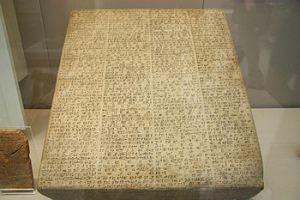 We are looking at what archaeological evidence was available in 1971 to support the writings of the Hebrew prophets in the Old Testament of the Bible. That’s when I was conducting an investigation, as an atheist, into the truth claims of theism and Christianity.
We are looking at what archaeological evidence was available in 1971 to support the writings of the Hebrew prophets in the Old Testament of the Bible. That’s when I was conducting an investigation, as an atheist, into the truth claims of theism and Christianity.
We’ve seen evidence for the men who prophesied during the years of the kings of Israel and Judah and the evidence for Jeremiah who prophesied during the years leading up to and following the Babylonian destruction of Jerusalem and beginning of Hebrew captivity in Babylon. Now we turn to the years of captivity.
According to secular sources, deported Jews spent 70 years of captivity in Babylon – from the beginning of forced detention in 597 BC to the end of exile in 538 BC. [One of the Babylonian Chronicles (ABC 5) details the involvement of Babylonian King Nebuchadnezzar in capturing Jerusalem.] While King Nebuchadnezzar had many wealthy and influential Jews deported to Babylon, thousands of the poorer Jews remained in Judah or fled to nearby countries.
Two Hebrew prophets lived in Babylon during the exile period: Daniel and Ezekiel. Jeremiah remained in Judah for a time until he was forcibly moved to Egypt. What archaeological evidence do we have to support the historical references in the Books of Daniel and Ezekiel? Let’s begin with Daniel.
Daniel Archaeology
Archaeologists have discovered records of three deportations of the people from Judah to Babylon: 605 BC, 597 BC, and 586 BC. The Jewish historian Josephus quoted the Greek historian Berossus concerning the campaigns of Nebuchadnezzar. Berossus lived during the 4th century BC and said he wrote the history of Babylonian kings based on numerous Babylonian historical books and chronologies available to him.
“Nabuchodonosor, as soon as he had received intelligence of his father’s death, set in order the affairs of Egypt and the other countries, and committed to some of his faithful officers the captives he had taken from the Jews, and Phœnicians, and Syrians, and the nations belonging to Egypt, that they might conduct them with that part of the forces which had heavy armour, together with the rest of his baggage, to Babylonia.” Berossus from Josephus, Sacred Texts
King Nabopolassar, who was Nebuchadnezzar’s father, died in 605 BC. Nebuchadnezzar rushed back to Babylon to claim his throne in that same year and instructed his army to escort Jewish captives to Babylon – the first of the three Babylonian captivities of the Jews.
That brings us to a Hebrew youth named Daniel.
“In the third year of the reign of Jehoiakim king of Judah, Nebuchadnezzar king of Babylon came to Jerusalem and besieged it. And the Lord gave Jehoiakim king of Judah into his hand, with some of the articles of the house of God, which he carried into the land of Shinar to the house of his god; and he brought the articles into the treasure house of his god.” Daniel 1:1-2
Jehoiakim became king of Judah after his father, King Josiah, died and the Egyptian pharaoh Necho made Jehoikim king. That was about 608 BC. The third year of Jehoiakim’s reign would have been about 606/605 BC, which is when Nebuchadnezzar defeated Egypt at Carchemish and besieged Jerusalem. That’s when Daniel and some of his friends were taken captive to Babylon.
“Then the king instructed Ashpenaz, the master of his eunuchs, to bring some of the children of Israel and some of the king’s descendants and some of the nobles,young men in whom there was no blemish, but good-looking, gifted in all wisdom, possessing knowledge and quick to understand, who had ability to serve in the king’s palace, and whom they might teach the language and literature of the Chaldeans. And the king appointed for them a daily provision of the king’s delicacies and of the wine which he drank, and three years of training for them, so that at the end of that time they might serve before the king. Now from among those of the sons of Judah were Daniel, Hananiah, Mishael, and Azariah. To them the chief of the eunuchs gave names: he gave Daniel the name Belteshazzar; to Hananiah, Shadrach; to Mishael, Meshach; and to Azariah, Abed-Nego.” Daniel 1:3-7
One remarkable aspect of this event happening in 605 BC is that Isaiah prophesied it would happen a century earlier. Here’s what Isaiah told King Hezekiah (reigned approx. 715 – 686 BC):
“Then Isaiah said to Hezekiah, ‘Hear the word of the Lord of hosts: ‘Behold, the days are coming when all that is in your house, and what your fathers have accumulated until this day, shall be carried to Babylon; nothing shall be left,’ says the Lord. ‘And they shall take away some of your sons who will descend from you, whom you will beget; and they shall be eunuchs in the palace of the king of Babylon.’” Isaiah 39:5-7
Daniel and his friends were members of the first wave of Hebrew captives to be taken to Babylon. The Babylonian who conducted them from Jerusalem to Babylon was ‘Asphenaz, the master of his eunuchs.’ The term rabsaris (rab she-reshi), ‘master of his eunuchs,’ was authenticated by an archaeological find in the late 19th century AD of a Babylonian clay tablet, dated to the early 6th century BC, currently on display in The British Museum. The prophet Jeremiah also used the same term when speaking about “princes of the king of Babylon.” (Jeremiah 39:3).
It’s interesting to note that Daniel rose to become one of the ‘princes of Babylon’ under Nebuchadnezzar.
“As for these four young men, God gave them knowledge and skill in all literature and wisdom; and Daniel had understanding in all visions and dreams. Now at the end of the days, when the king had said that they should be brought in, the chief of the eunuchs brought them in before Nebuchadnezzar. Then the king interviewed them, and among them all none was found like Daniel, Hananiah, Mishael, and Azariah; therefore they served before the king. And in all matters of wisdom and understanding about which the king examined them, he found them ten times better than all the magicians and astrologers who were in all his realm. Thus Daniel continued until the first year of King Cyrus.” Daniel 1:17-21
“Then the king promoted Daniel and gave him many great gifts; and he made him ruler over the whole province of Babylon, and chief administrator over all the wise men of Babylon. Also Daniel petitioned the king, and he set Shadrach, Meshach, and Abed-Nego over the affairs of the province of Babylon; but Daniel sat in the gate of the king.” Daniel 2:48-49
“Then the king promoted Shadrach, Meshach, and Abed-Nego in the province of Babylon.” Daniel 3:30

Courtesy British Museum
The comments of King Nebuchadnezzar in Daniel 4:30 – “Is not this great Babylon, that I have built for a royal dwelling by my mighty power and for the honor of my majesty?” – are similar to the boastful words of Nebuchadnezzar engraved on an ancient Babylonian tablet (discovered in ruins of Babylong before 1801 AD) known as the ‘East India House Inscription’ on display in the British Museum in London.
One of the interesting aspects of the Book of Daniel is his use of both Hebrew and Aramaic. Aramaic was a lingua franca (common or bridge language used between nations) during ancient times. The Hebrew writing in Daniel is consistent with a 6th century BC dating (similar to Ezekiel’s Hebrew) and the Aramaic in Daniel is similar to the Elephantine Papyri and the imperial Aramaic of the 5th century BC. In fact, Daniel has been shown to have been “written in a form of Imperial Aramaic (Reichsaramaisch), an official or literary dialect which had currency in all parts of the Near East” (Archer, Survey, 397. Cf. Jeffery, “Book of Daniel,” 349; W. J. Martin, “Language of the Old Testament,” NBD; F. Rosenthal, Die aramaistische Forschung (Leiden: Brill, 1964), 60.). Edwin Yamauchi wrote that “Discoveries, such as Adon’s letter in Aramaic (sixth cent. B.C.), have confirmed the fact that the Aramaic of Ezra and of Daniel is basically the same as the Aramaic of the sixth-fifth centuries as we know it from contemporary evidence” (Yamauchi, Greece and Babylon, 91 (Grand Rapids: Baker, 1967). (For more information, read The New American Commentary Volume 18: Daniel, Stephen R. Miller, B& H Books, 1994)
Daniel changed from Hebrew to Aramaic in Daniel 2:4 – “Then the Chaldeans spoke to the king in Aramaic, ‘O king, live forever! Tell your servants the dream, and we will give the interpretation” – and changed back to Hebrew after Daniel 7:28 – “This is the end of the account. As for me, Daniel, my thoughts greatly troubled me, and my countenance changed; but I kept the matter in my heart.”
Dating Daniel to the 6th century BC is remarkable in light of the accuracy of his interpretation of King Nebuchadnezzar’s dreams (Daniel 2:31-45). Daniel ended the interpretation with these words – “The dream is certain, and its interpretation is sure.” (Daniel 2:45b) History has revealed that the first four kingdoms from Nebuchadnezzar’s dream were the Babylonian, Persian, Greek and Roman empires. The fifth kingdom (feet and ten toes of statue) is thought by some scholars to be a future revived Roman empire prior to Christ’s return (Daniel 2:41-44; Revelation 17:12-14; 19:11-21).
Please join us next time as we continue to investigate the archaeological evidence for the Book of Daniel.
Scripture taken from the New King James Version®. Copyright © 1982 by Thomas Nelson. Used by permission. All rights reserved.

